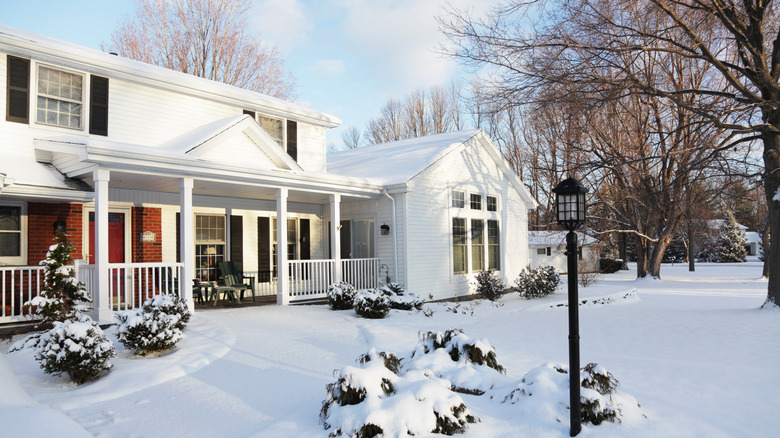Don't Forget To Clean One Crucial Spot After A Heavy Snow
Between your vehicles, walkways, driveways, porches, and more, cleaning up after a winter storm is a time-consuming task. With these handy hacks, clearing outdoor snow and ice gets a lot easier. As you compile your list of areas to clean, be sure to include your furnace vents. Forgetting to check on them after a heavy snow can pose a health risk for everyone indoors.
In the United States, most homes use a central furnace for heating. Vents ensure that hazardous gasses make their way out of your home. That's part of why you should think twice before closing any vents for winter. However, they can get blocked by snow and ice. If that goes unchecked, carbon monoxide (CO) levels may build in your home. Known as "the silent killer," CO is odorless, tasteless, and non-irritating, so it can go unnoticed. The initial symptoms of CO poisoning include headaches, nausea, and dizziness, and they can progress to more severe ones, like a loss of consciousness, before death. To prevent CO poisoning, you should install detectors and test them monthly.
Besides potential health risks, there are more ways that snow can damage your HVAC system. Blocked vents force your furnace to work harder to maintain your desired temperatures. This may not only increase your heating bill but also shorten your furnace's lifespan. Plus, the extra weight of snow and ice can put a lot of strain on your pipes and vents. Although specifics vary, the average snow weighs about 15 pounds per cubic foot, and that's not including any ice.
Ways to keep snow out of your furance vent
When removing snow from your furnace vent, you should do so by hand, as shovels or snow blowers may damage the pipe. During this time, you should also check on your meter and other often-forgotten areas, like your dryer vents. Keep in mind that if the blockage is big enough, your furnace may shut itself down as a safety measure. Don't panic if that happens. To restart your furnace, follow the manufacturer's instructions after you've removed any snow or ice. If you're uncomfortable doing so yourself, you can also call in a professional.
Lastly, you can also look into methods to prevent future blockages, like building your own A-frame diverter. This project is a really easy one to tackle on your own, even as a complete beginner, because it doesn't need to be pretty. It just needs to work. To construct one, all you need is 1/2-inch plywood, strap hinges, and stainless steel screws and nuts. Cut your plywood sheet in half, and attach the pieces with the hinges on the inside for extra protection. You can also spray your metal attachments with zinc coating to prevent corrosion from the elements.
People who have used this preventative measure seem satisfied with it. One commenter on the YouTube video above wrote, "Our furnace pipes always clog [because] they are in an area that is a wind tunnel." After a recent heavy storm, though, they said the A-frame "saved us and our furnace. I think both the intake and exhaust pipes would have been buried."
